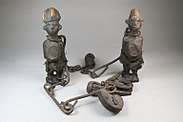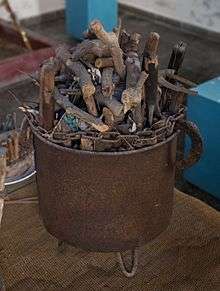Palo (religion)
Palo, also known as Las Reglas de Congo, is a religion with various denominations which developed in Cuba among enslaved Central African people and their descendants who originated in the Congo Basin. Denominations often referred to as "branches" of Palo include Mayombe (or Mallombe), Monte, Briyumba (or Brillumba), and Kimbisa. The Spanish word palo "stick" was applied to the religion in Cuba due to the use of wooden sticks in the preparation of altars, which were also called la Nganga, el caldero, nkisi or la prenda. Priests of Palo are known as Paleros, Tatas (men), Yayas (women) or Nganguleros. Initiates are known as ngueyos or pino nuevo.[1][2][3]
| Palo | |
|---|---|
| Type | Syncretic |
| Classification | Afro-Cuban |
| Origin | Slavery era Cuba |
| Other name(s) | Las Reglas de Congo |
History
Palo has its roots in the Congo Basin of Central Africa, from where large numbers of enslaved Kongolese people were brought to Cuba where the religion evolved. It's mainly a product of BaKongo religion but has been influenced by other faiths.[4] Palo's liturgical language is a mixture of the Spanish and Bantu languages, known as lengua, bozal or habla Congo.[2]
Belief system and rituals
| Part of a series on |
| Kongo religion |
|---|
 |
| Theology and concepts |
| Derivatives |

The Palo belief system rests on two main pillars:
- The veneration of the spirits.
- The belief in natural/earth powers.
All natural objects, and particularly sticks, are thought to be infused with powers, often linked to the powers of spirits. This differs from the orishas of Santería and other Yoruba religions, which are associated with archetypal human beings.[2]
A certain number of spirits called Kimpungulu (singular: Mpungu) inhabit the Nkisi (sacred objects; also spelled Enkisi, Inquice, or Inquise). Kimpungulu are well known in name and deed, and are often venerated as spirits with anthropomorphic qualities. They are powerful entities, but they are ranked below the Supreme Creator Zambi or Nzambi, making Palo a henotheistic religion.
The main practice of Palo focuses upon the religious receptacle or altar known as "la Nganga", "el caldero", "nkisi" or "la prenda." This is a consecrated vessel which serves as a microcosm. Each Nganga is dedicated to a specific mpungu. Often, this religious vessel is also believed to be inhabited by a spirit of the dead (almost never the direct ancestor of the object's owner), also referred to as "Nfumbe", who acts as a guide for all religious activities which are performed with the Nganga. Colors, clothing, and stylized dances associated with a particular deity, a common feature of Santeria and other Yoruba religion, are not found in Palo.[2]
Music in Palo practices begins with wooden percussion instruments followed by drums. Examples are the catá, guaguá, and the ngoma, or conga. The cowbell, hoe, and plow are used as metallic instruments.[3]
Various divination methods are used in Palo. Chamalongos uses shells of various materials, often coconut shells. A more traditional method, Vititi Mensú, is a form of envisioning or scrying using a sanctified animal horn capped with a mirror.
Denominations are further broken down into temple homes known as munansós that are headed by an experienced elder priest or priestess. There is no central authority figure in Palo.
Syncretism
Religious syncretism with Catholicism is prevalent within Palo due to the fact that the Kingdom of the Kongo adapted the Catholic religion and created a form of Kongo-Catholicism as early as the 15th century. Iconography and the lack thereof is a reflection of dual socio-politics beliefs that have been in opposition for centuries. In Cuba they are categorized as Palo Cristiano (Christian Palo), which uses the crucifix and images of Catholic saints as representations of the kimpungulu versus Palo Judio (Jewish Palo), where there is no Catholic imagery/iconography to be found. Although the name Palo Judio literally means "Jewish Palo" the term "Jewish" as used here does not refer to Judaism; rather it is metaphorical shorthand for "refusing to convert to Christianity", that is, in the case of Palo, "purely Congo."[5]
Higher gods
- Nkuyu (Mukudji, Nkuyu, Mañunga, Lubaniba, Lucero, Lucero Mundo, Remolino, Cuarto Vientos, Kbuyu) - the deity of forests and roads, a guide and balance. He guards the entry of a cemetery and is considered the guardian of the moon. He is equivalent to Elegua or Eshu in Yoruba religion and associated with the Holy Infant of Atocha.
- Kengue (Mama Kengue, Yola, Tiembla Tierra, Pandilanga) - the Sky Father and the primordial creator of all life, and deity of knowledge and justice, equivalent to Obatala in Yoruba religion and syncretized with the Virgin of Mercy.
- Sarabanda (Zarabanda, Rompe Monte) - a strong and willful deity, equivalent to Ogum in Yoruba religion and associated with Saint Peter. The Nganga dedicated to Sarabanda must be made of iron with three legs.[1]
- El Cristo Negro - is the black version of Jesus Christ and all spirits bow to his all-powerful authority. Black crows and roosters are associated with El Cristo Negro.
- Mama Chola - is the Goddess of Fertility & Love. She is associated with Oshun the Orisha Spirit of Beauty & Love.
Controversy
Palo has been linked to a rash of grave robbing in Venezuela. Residents report that many of the graves at Caracas' Cementerio General del Sur have been pried open to have their contents removed for use in Palo ceremonies.[6]
Similar activities were also reported in the United States. In 1995, the US Fish and Wildlife Service arrested a Palo Mayombe high priest in Miami, Florida, who was in possession of several human skulls as well as the remains of exotic animals.[7] In Newark, New Jersey, in 2002, a Palo practitioner was found to have the remains of at least two dead bodies inside pots within the basement, along with items looted from a tomb.[8] A Connecticut Palo Mayombe priest was arrested in 2015 for allegedly stealing bones from mausoleums in a Worcester, Massachusetts, cemetery.[9]
References
- Manual del palero: prendas, fundamentos, entidades, plantas mágicas, trabajos y firmas. Publisher unknown. 2017. pp. 8–9.
- Schmidt, Jalane (2017). "Regla de Palo". Africana: The Encyclopedia of the African and African American Experience (2 ed.).
- West-Durán, Alan (2008). "Cuban Ritual Music, African Influence in". In Juang, Richard M. (ed.). Africa and the Americas: Culture, Politics, and History. ABC-CLIO.
- Erwan Dianteill. Kongo in Cuba: the Transformations of an African Religion. Centre for the Interdisciplinary Study of Religious Phenomena. pp. 59–80.
- ""Jewish" and "Christian" Palo in Cuba". Archived from the original on 2012-07-05. Retrieved 2012-05-25.
- Romero, Simon (2009-12-11). "Palo (Religion) In Venezuela, Even Death May Not Bring Peace". The New York Times. Retrieved 2010-05-21.
- Pacenti, John (15 February 1998). "'Occult Cop' Walks Beat on the Dark Side". Los Angeles Times. Retrieved 16 February 2018.
- William Mcgowan (November 8, 2002). "Resting Without Peace". Wall Street Journal.
Just a month ago, Newark police raided the scruffy tenement at Central and Norfolk. Inside a basement worship room, 10-gallon Palo pots held at least two sets of human remains, including two skulls. ...
- "Judge suppresses some evidence in human bone theft case". The Seattle Times. Associated Press. 16 February 2018. Retrieved 16 February 2018.
Further reading
- Lydia Cabrera. 1993 "El Monte". La Habana: Editorial Letras Cubanas.
- Lydia Cabrera. "Palo Monte Mayombe: Las Reglas de Congo" .
- Lydia Cabrera. "La Regla Kimbisa del Santo Cristo del Buen Viaje".
- Jesús Fuentes Guerra and Armin Schwegler 2005.Lengua y ritos del Palo Monte Mayombe:...
- Erwan Dianteill. "Kongo in Cuba" (English), Archives-de-sciences-sociales-des-religions, 2002
- Natalia Bolívar Aróstegui. "Ta Makuenda Yaya"
- Miguel Barnet. "AfroCuban Religions."
- Robert Farris Thompson. "Flash of the Spirit."
- Jeff Lindsay. "Dexter in the Dark." 2007.
- Nicholaj De Mattos Frisvold. "Palo Mayombe, The Garden of Blood & Bones." 2010
- Todd Ramon Ochoa. "Society of the Dead: Quita Managuita and Palo Praise in Cuba" University of California Press, 2010.
External links
- Kimbisa.org, roundtable discussions of issues in Palo, hosted by Palo Priests.
- Nganga.org, general information on Bantu religions in the diaspora.
- Palo, Comparative African religions
- Palomayombe.org, in-depth information on Palo Mayombe.
- Palomayombe.com, general information.
- Palo-mayombe.com, general Palo Mayombe information.
- Palo, Congo, Inkisi at Curlie
- Video of Palo ceremony for Má Lango, also known as Madre de Agua, at a beach in Santiago de Cuba Jul-2014 (YouTube)